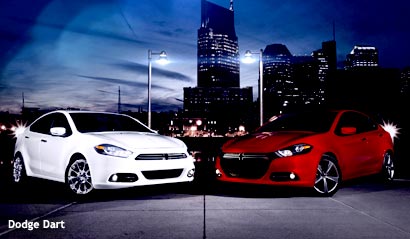automotive
Designer Dehner Talks Dodge Dart
- by Karl Greenberg , May 12, 2012

When the 2013 Dodge Dart arrives in a few weeks, it is bringing along a carload of interior and exterior designers who have tried to re-engineer Fiat S.p.A.'s Alfa Romeo Giulietta for the U.S. market. Whether they succeed depends on how well they walked the cornice between brand authenticity and innovation (rather than leaning too heavily on design cues from another vehicle.)
While that is the challenge in most industrial design, it's especially true in the automotive world. "Designers are artists. But with industrial design you are creating art for the masses. We used to not listen so much to the voice of consumers, but now we do, and we have to filter out what's design actionable," says Joe Dehner, head of exterior design for Dodge and Ram, who was in New York last week to offer a look at the range of Darts aiming for U.S. dealer showrooms next month.
advertisement
advertisement
Dehner says the car -- which was designed to pique the interest of Millennials and Boomers alike -- recalls that the initial (and near-final) design had too much of a "boy racer" look. He explains that the designers who worked on the exterior of the car were young men juiced up about working on the U.S. version of the Alfa. "So they are doing what they want with design, adding spoilers, scoops, and the like. It was a matter of letting them have their fun and then reeling them in," says Dehner. "This is a C-segment car with mass appeal, so we have to be cognizant of that."
One feature was the vehicle's monographic black grill that gave the car an aggressive look. They took that design to market research. "Right in the closing minutes of finishing that program we got feedback that a lot of middle-aged women said that it was a nice front end, but 'it's not me; it's too aggressive.' It was like a knife through the heart," he says. Rather than tone it down, which would have meant a lot of reworking, the key was to keep that more aggressive version, and then add versions with less masculine split grills. Dehner says the task turned out to be an easy problem to solve because the horizontal panel splitting the grill is not part of the body, and can easily be swapped out for one that is the same color as the rest of the vehicle, which softens the look of the "face."
Dehner tells Marketing Daily that the solution meant Dodge was able to offer different versions of the car to appeal to different consumer cohorts: the R/T and Rallye versions with the single-tone black grill would appeal to younger guys, and the other versions for older consumers and perhaps more women.
Dehner pointed out another interesting feature of the vehicle -- one that probably gets scant attention from shoppers, at least consciously: the placement of the twin exhausts. Typically, these tend to be either free-floating beneath the rear fascia, or more or less centered in what engineers call the "mouse holes" in the lower rear panel. The problem with that alignment is that over time it goes off center because the exhaust tips move around. And while that's no big deal functionally, it's an aesthetic letdown that cheapens the look of the vehicle. "And the assembly process for the worker to align that tip, and have it 100% right, means a lot of time invested in getting it just right," he says. So the chrome tips on the Dart's exhaust are mounted on the fascia.
The Dart also leans toward a dark (the official name of the hue is "diesel") color, per Dehner, who says Millennials like black interiors, and also prefer sedans over coupes, and like technology. "Until now, we really had not done an entry-level car that was a standout product -- that really got their attention. Hopefully, the Dart will turn that around. [Millennials] want to be stealthy, not ostentatious -- and they want their vehicle to reflect the fact that they made an intelligent purchase decision. It needs to be authentic and true to what Dodge represents: sporty, sexy. But it also has an air of formality about it."
Dehner says the design group for Dodge started to move away, philosophically, from the idea that the alpha and omega in American sports car design and personality is the traditional muscle car. "You know, the Dodge brothers made bicycles before they made cars, and a couple of years ago, when Ram split away from Dodge, we decided to think about performance in terms of human performance," he says. "So we actually started looking at racing bicycles and endurance riders, and their aerodynamic helmets and gear. It's the idea, partly, that bicycle racers use a wheeled device, but human-powered; it's a new expression of performance that is clean, sustainable, Earth-friendly."
The design team also played around with visual paradoxes and neologisms, like "Aerodramatic," to kind of embody the idea that a driver's car doesn't have to be sheet-metal machismo. "We had a picture on the wall that we go back to a lot," he says. "We took a photograph of an ice cube and Photoshopped it." The photo is of an ice cube on fire.




